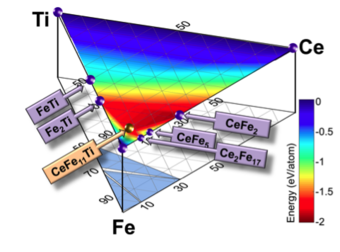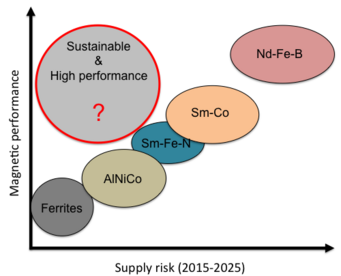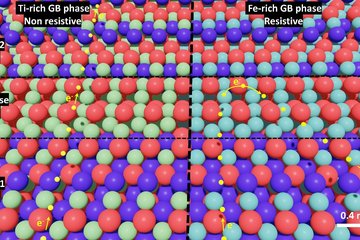Ab-initio Phase Stabilities of Ce-based Hard Magnetic Materials
The thermodynamic stability of computationally designed multicomponent compounds against decomposition into structures with less favorable properties is often unclear. In this project, we have used sophisticated finite temperature ab initio methods to determine the relative phase stabilities of promising Ce-Fe-Ti hard-magnetic materials.
Many rare-earth (RE) transition metal (TM) compounds have magnetic properties that make them promising candidates for novel hard magnets. The latter have recently received a lot of technical and scientific attention due to their crucial importance for the functionality and performance of many industrial applications such as electrical engines and wind turbines. At the same time, the growing demand for Nd-Fe-B magnets and a production monopoly in the global markets raised the need for alternative materials [1], which are sustainable and high performance shown in Fig. 1. Meanwhile, various compositions have been predicted to show an excellent magnetic performance, e.g., identified by using high-throughput screening methods [2]. However, as long as their thermodynamic stability is still unclear, it will be hard to cast and process them.
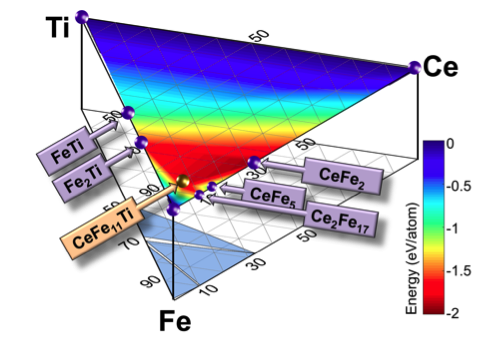
Fig. 2: ab initio based formation diagram of Ce-Fe-Ti alloys at 1500 K
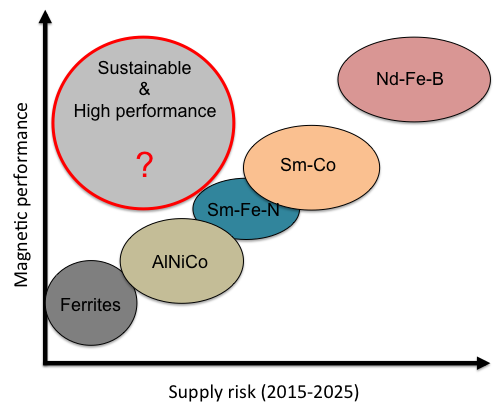
Fig. 1: Medium term supply risk vs. performance as a hard-magnetic compound for different materials classes
In order to overcome that uncertainty, we extend our sophisticated ab initio based finite temperature methods towards the phase stability of ternary alloys [3]. We have chosen Ce-Fe-Ti alloys as a prototype system for this purpose, shown in Fig. 2. The focused on Ce-based alloys is motivated by the abundance and accessibility of Ce and the potential high magnetic anisotropy caused by the dependence of the valency on steric volume.
The main challenge for Ce-based hard magnetic materials is the appearance of secondary phases in the microstructure, such as CeFe2. These phases retard the desired hard magnetic performance of CeFe11Ti. Employing state-of-the-art approaches for vibrational, electronic, magnetic and configurational entropy contributions, the Helmholtz free energy, F(T,V), is calculated for the promising hard magnetic and other competing phases. In order to test the reliability of the calculated free energies, we compared the theory with available experimental properties such as phonon dispersions and heat capacities [4]. The construction of a three-dimensional convex hull leads us to understand the relative stability for all phases and to identify the physical conditions under which such detrimental phases suppress the formation of hard magnetic phases.
In order to tailor relative stabilities and promote the desired hard magnetic phase, we perform substitutional doping within the dilute limit in a grand canonical approach. We develop a screening methodology that considers all 3d and 4d elements as alloying components and captures their effect on the critical temperature above which the desired hard magnetic phase is thermodynamically stable. Similar to Calphad, our approach is therefore suited to calculate ternary and quaternary phase diagrams, while a full understanding of the relative stabilities and magnetic properties is achieved in addition.
References
[1] M. Pellegrini. Report on Critical Raw Materials for the EU Critical Raw Materials Profiles (2014)
[2] N. Drebov, A. Martinez-Limia, L. Kunz, A. Gola, T. Shigematsu, T. Eckl, P. Gumbsch, and C. Elsässer. New Journal of Physics 15, 125023 (2013)
[3] H.I. Sözen, S. Ener, F. Maccari, K.P. Skokov, O. Gutfleisch, F. Körmann, J. Neugebauer, T. Hickel, Phys. Rev. Mater. 3, 084407 (2019)
[4] H.I. Sözen, T. Hickel, J. Neugebauer, Calphad 68, 101731 (2020).
